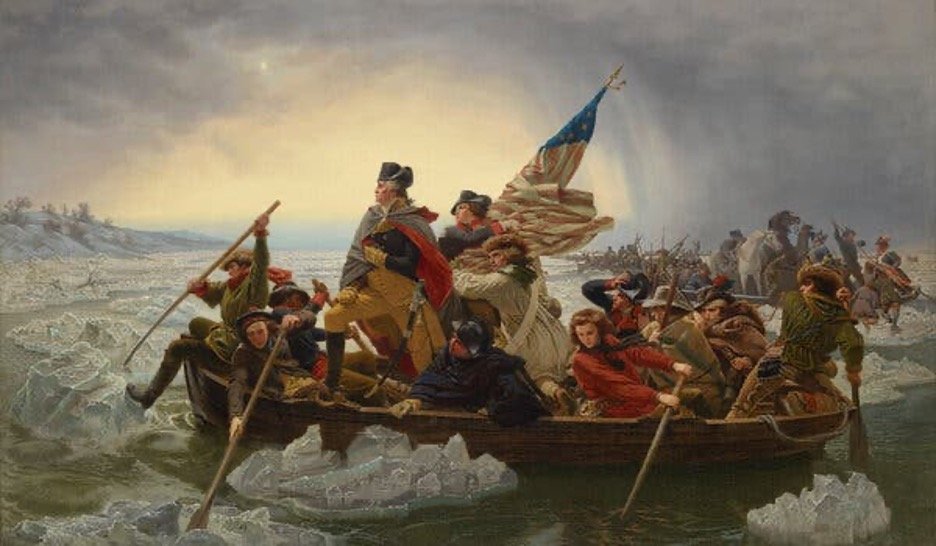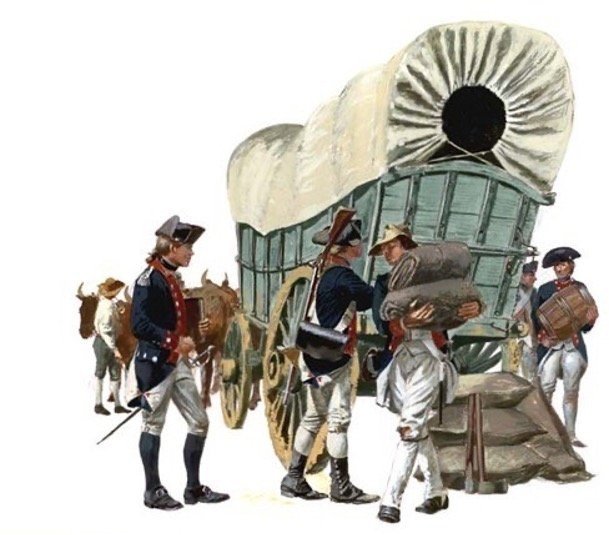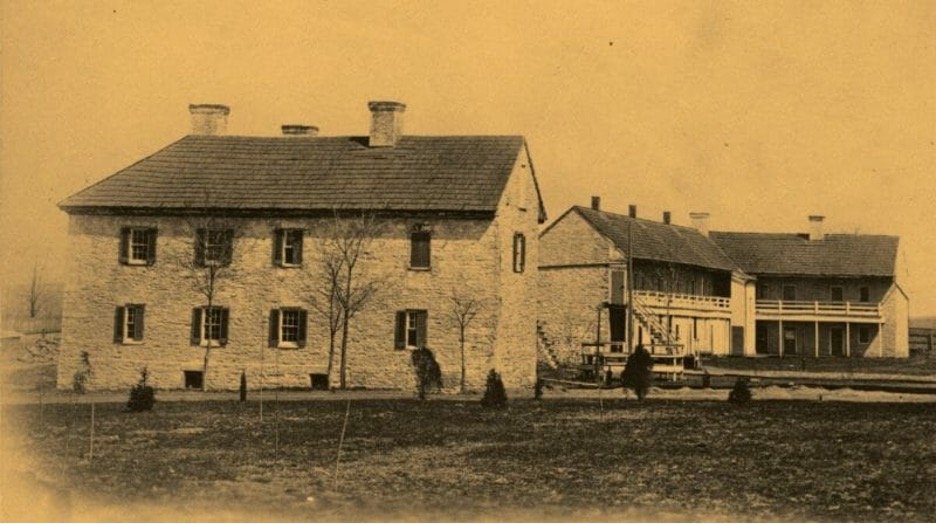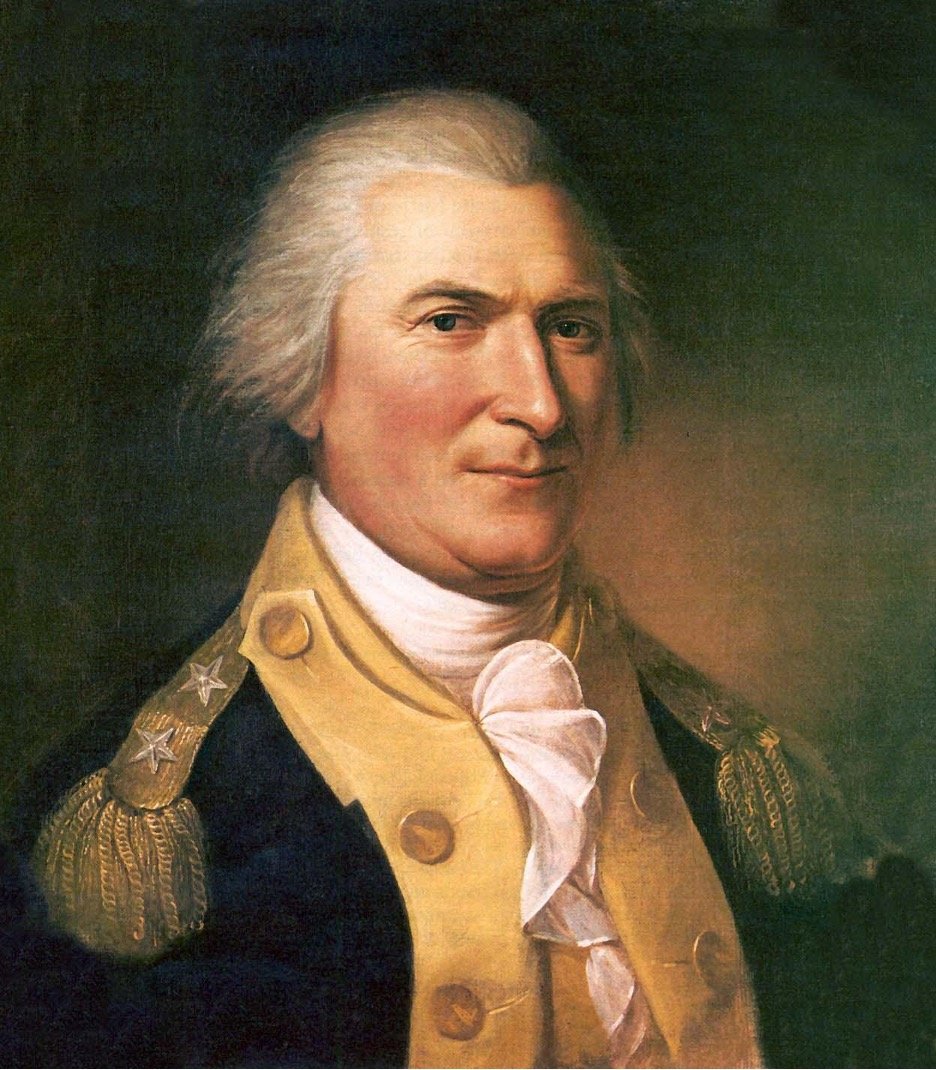As the United States annually celebrates the 4th of July as the birth of our nation, what many forget is that the day only marks the ratifying of the Declaration of Independence. In fact, many of the famous signatures laid upon that document were not even etched in until August 2nd of that year. And more importantly, the many famous battles of the Revolutionary War were fought in the years following, not leading up to.
My 4th great grandfather, Hezekiah Marshall, testified to participating in one of those well-known engagements, The Battle of Trenton. In October of 1776, Hezekiah and his father’s team in Frederick, Maryland, were pressed into the service to haul baggage for the U.S. army, most of the time under the command of General Nathaniel Greene. At this time, and over the next two months, the Continental Army appeared to be on the losing side, and morale was low.

Emanuel Leutze, 1851, oil painting of Continental soldiers unloading military provisions from a Conestoga wagon.
But Christmas evening 1776 brought new hope. The notorious image above depicts General Washington crossing the icy Delaware before launching a surprise morning attack on a garrison of 1,500 Hessian soldiers who were in league with the British armies. It was a victory, and one that Hezekiah played a part in as a waggoner. He claimed to have been wounded in the leg by a musket ball that day.
At the onset of his involvement, he was only about the age of 13 to 14, and his dad would have been about 31 years of age. They continued to be of service until the following Christmas in 1777, according to Hezekiah’s pension application deposition. Their names cannot be found on any surviving muster rolls, and a possible reason for this could be explained by the fact that Hezekiah’s father was mixed race. He was one quarter Black, and George Washington had strongly advised against the recruitment of Black soldiers (free or enslaved) – though that rule was not executed to the fullest extent. Apart from that, Hezekiah’s retelling of his and his father’s participation in the war, can subjectively be interpreted as forced volunteerism rather than having formally been drafted.

Continental soldiers unloading military provisions from a Conestoga wagon.
Regardless of the nature of his recruitment, after returning home for a period of 2-3 years, Hezekiah once again came to the assistance of the patriots, but in his own hometown of Frederick, Maryland. In 1780, he volunteered for a term of six months as a Private under Captain Deterno, Lieutenant Jacob Stoner, and Major Miller, guarding the military’s magazine and store. He extended his term another six months following that, though absent for one of those months, until he was officially discharged.
His next tour was in March when he was assigned to guard prisoners. The Frederick Barracks (pictured below) held mercenary soldiers from Germany between the years of 1780 – 1781. They had been captured at places such as Yorktown, Saratoga, and Trenton. One of the barracks is still in existence and open to the public and is situated on the grounds of the Maryland School for the Deaf.**

Frederick Hessian Barracks; https://frederickhistory.org/category/early-inhabitants/
It’s unclear whether Hezekiah was assigned to the Frederick Barracks or elsewhere, though due to proximity and timing, it seems likely. He reported performing this engagement partly for himself and partly as a substitute for Joseph Cumberledge, in exchange for $20. Cumberledge was known to reside in Frederick Town at the time, also. He and his family later moved to the wilderness near the village of Brave in Wayne Township, Pennsylvania, and were sadly all killed by Indians on 23 April 1789.*
Hezekiah’s next tour was a four month volunteer engagement as a militia man. Finally, in September 1783, the Treaty of Paris was signed, officially ending the American Revolution. Unfortunately, not even that brought an end to the fighting.
In 1791, Hezekiah served 6 additional months with the army under General St. Clair taking up arms against the Indians. Arthur St. Clair had been appointed to the position by then elected President George Washington. He was ordered to “take care of” the native tribes north of the Ohio River.

Charles Willson Peale, 1782, portrait of Arthur St. Clair.
However, St. Clair did not ready his men for this undertaking. On the morning of November 4, 1791, St. Clair’s encampment came under attack by Native American warriors. At least 900 of his soldiers were killed or wounded, and only a few hundred managed to escape, Hezekiah being one of the lucky few. They retreated to Fort Washington on the banks of the Ohio River. And it’s said President Washington exclaimed St. Clair was “worse than a murderer” when he learned of the defeat.***
When Hezekiah first approached the U.S. government for a pension, he did not mention this trial, as he had been advised it would not entitle him to any additional pension beyond the 15 months as a volunteer militia man. In total, the length of time Hezekiah actually served equated to 2 years and 5 months.
His father’s house in Frederick County, Maryland, was destroyed by fire by the local indigenous population in 1792, and with it, any paperwork proving his birth and/or military service. His word and that of his widow’s in the pension application documents are all that remain of the tales of his service. At least three others, including Sheriff David A. Worley, also testified as witnesses to knowing Hezekiah had been an active patriot, though none of these witnesses had known Hezekiah during his actual years in service.
Hezekiah first applied for a pension at the rate of $30 annually starting in 1831 at the age of 71. He appeared in court for a second time in November of 1838 in Greene County, Pennsylvania, inquiring as to the status and fate of his pension, noting he lived in a remote part of the country and was too old and infirm to have followed up previously. It would seem he did not live long enough to receive the distributions. He passed away 4 years later in 1842, apparently still owed his due by the government.

Hezekiah Marshall, Revolutionary War pension application.
But his widow, my 4th great grandmother, Athe (Neal) Marshall, did receive it on his behalf. She also received a parcel of bounty land located in Missouri. It was nowhere near where she resided, so she sold it (which was quite common for pensioners to do). In her case, the purchaser happened to be the agent who was assisting her in collecting Hezekiah’s pension.

Athe Marshall, Revolutionary War bounty land grant.
Hezekiah’s participation in the war was not passed down through the family as one might expect such heroic actions to be. Instead, rather than hearing of his job as an Indian spy in the Revolution, oral tradition twisted the story into him being Native American himself. In any case, he did contribute to our nation’s independence from Britain, and he’s to be celebrated every 4th of July.
*Credit: https://greenesaver.com/union-forever-a-family-in-the-civil-war/
**Credit: https://frederickhistory.org/category/early-inhabitants/
***Credit: https://www.mountvernon.org/library/digitalhistory/digital-encyclopedia/article/arthur-st-clair/
Comments
Post a Comment